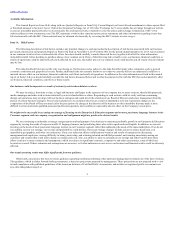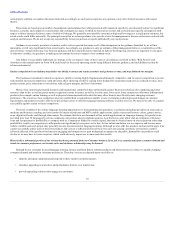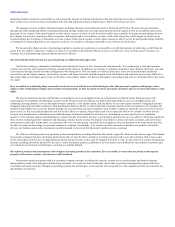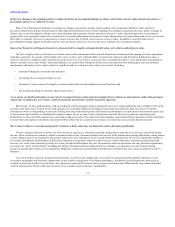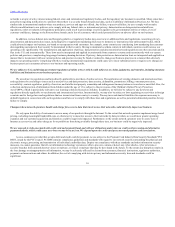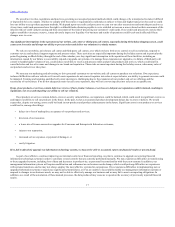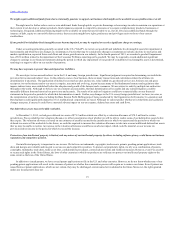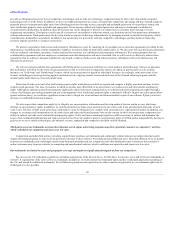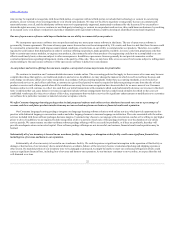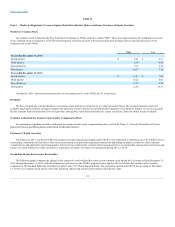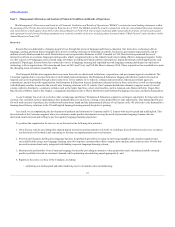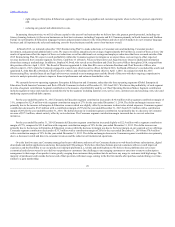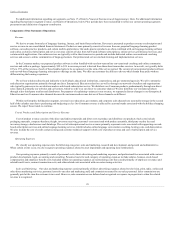Rosetta Stone 2015 Annual Report Download - page 20
Download and view the complete annual report
Please find page 20 of the 2015 Rosetta Stone annual report below. You can navigate through the pages in the report by either clicking on the pages listed below, or by using the keyword search tool below to find specific information within the annual report.
Table of Contents
We might require additional funds from what we internally generate to support our business which might not be available on acceptable terms or at all.
We might need to further reduce costs or raise additional funds through public or private financings or borrowings in order to maintain our operations at
their current level, develop or enhance products, fund expansion, respond to competitive pressures or to acquire complementary products, businesses or
technologies. If required, additional financing might not be available on terms that are favorable to us, if at all. If we raise additional funds through the
issuance of debt, equity or convertible debt securities, these securities might have rights, preferences and privileges senior to those of our current
stockholders.
If our goodwill or indefinite-lived intangible assets become impaired, we may be required to record a significant charge to earnings.
Under accounting principles generally accepted in the U.S. ("GAAP"), we review our goodwill and indefinite lived intangible assets for impairment at
least annually and when there are changes in circumstances. Factors that may be considered a change in circumstances include a decline in stock price and
market capitalization, expected future cash flows and slower growth rates in our industry. In the fourth quarter of 2015, we recorded a goodwill impairment
loss of $5.6 million related to the impairment of the Consumer Fit Brains reporting unit's goodwill. We may be required to record additional significant
charges to earnings in our financial statements during the period in which any impairment of our goodwill or indefinite lived intangible assets is determined,
resulting in a negative effect on our results of operations.
We may have exposure to greater than anticipated tax liabilities.
We are subject to income and indirect tax in the U.S. and many foreign jurisdictions. Significant judgment is required in determining our worldwide
provision for income and indirect taxes. In the ordinary course of our business, there are many transactions and calculations where the ultimate tax
determination is uncertain. The application of indirect taxes (such as sales and use tax, value-added tax, goods and services tax, business tax and gross
receipt tax) to our businesses and to our users is complex, uncertain and evolving, in part because many of the fundamental statutes and regulations that
impose indirect taxes were established before the adoption and growth of the Internet and e-commerce. We are subject to audit by multiple tax authorities
throughout the world. Although we believe our tax estimates are reasonable, the final determination of tax audits and any related litigation could be
materially different from our historical tax provisions and accruals. The results of an audit or litigation could have a material effect on our financial
statements in the period or periods for which that determination is made. Further, any changes to the U.S. or any foreign jurisdictions’ tax laws, tax rates, or
the interpretation of such tax laws, including the Base Erosion Profit Shifting project being conducted by the Organization for Economic Co-operation and
Development could significantly impact how U.S. multinational corporations are taxed. Although we cannot predict whether or in what form any legislation
changes may pass, if enacted it could have a material adverse impact on our tax expense, deferred tax assets and cash flows.
Our deferred tax assets may not be fully realizable.
At December 31, 2015, we had gross deferred tax assets of $79.2 million which was offset by a valuation allowance of $70.5 million for certain
jurisdictions. We recorded that tax valuation allowance to reflect uncertainties about whether we will be able to realize some of our deferred tax assets before
they expire. The valuation allowance is based on our estimates of taxable income for the jurisdictions in which we operate and the period over which our
deferred tax assets will be realizable. In the future, we could be required to increase the valuation allowance to take into account additional deferred tax assets
that we may be unable to realize. An increase in the valuation allowance would have an adverse impact, which could be material, on our income tax
provision and net income in the period in which we record the increase.
Protection of our intellectual property is limited, and any misuse of our intellectual property by others, including software piracy, could harm our business,
reputation and competitive position.
Our intellectual property is important to our success. We believe our trademarks, copyrights, trade secrets, patents, pending patent applications, trade
dress and designs are valuable and integral to our success and competitive position. To protect our proprietary rights, we rely on a combination of patents,
copyrights, trademarks, trade dress, trade secret laws, confidentiality procedures, contractual provisions and technical measures. However, even if we are able
to secure such rights in the United States, the laws of other countries in which our products are sold may not protect our intellectual property rights to the
same extent as the laws of the United States.
In addition to issued patents, we have several patent applications on file in the U.S. and other countries. However, we do not know whether any of our
pending patent applications will result in the issuance of patents or whether the examination process will require us to narrow our claims. Even if patents are
issued from our patent applications, which are not certain, they may be challenged, circumvented or invalidated in the future. Moreover, the rights granted
under any issued patents may not
19


